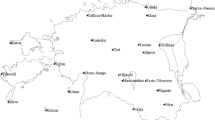Abstract
Spatial and temporal characteristics of snow depth, snow density, and snow water equivalent in the mountainous regions of Iran were investigated. It is obtained that in the mountainous regions the coefficients of variation (CV) for snow depth in January, February, March and April are smaller than on the plain and decrease in April. CV estimates for snow density were smaller, and those for snow water equivalent are greater than the corresponding CVs for snow depth. The regional CV patterns were similar for the three variables. The trend in their variations was assessed using the nonparametric Mann–Kendall test. The results showed that the three snowpack characteristics were stationary during the last four decades. There is a decreasing or increasing trend in three of the nine stations. The spatial variability of three snowpack characteristics was assessed using the inverse weighted distance squared (IDW) technique.
Similar content being viewed by others
References
S. P. Anderton, S. M. White, and B. Alvera, “Evaluation of Spatial Variability in Snow Water Equivalent for a High Mountain Catchment,” Hydrol. Processes, 18 (2004).
B. Balk and K. Elder, “Combining Binary Decision Tree and Geostatistical Methods to Estimate Snow Distribution in a Mountain Watershed,” Water Resour. Res., 36 (2000).
D. Bocchiola and B. Groppelli, “Spatial Estimation of Snow Water Equivalent at Different Dates within the Adamello Park of Italy,” Cold Regions Science and Technology, 63 (2010).
Y. Dinpashoh, D. Jhajharia, A. Fakheri-Fard, et al., “Trends in Reference Crop Evapotranspiration over Iran,” J. Hydrol., 399 (2011).
T. A. Erickson, M. W. Williams, and A. Winstral, “Persistence of Topographic Controls on the Spatial Distribution of Snow in Rugged Mountain Terrain, Colorado, United States,” Water Resour. Res., 41 (2005).
J. Erxleben, K. Elder, and R. Davis, “Comparison of Spatial Interpolation Methods for Estimating Snow Distribution in the Colorado Rocky Mountains,” Hydrol. Processes, 16 (2002).
S. R. Fassnacht, K. A. Dressler, and R. C. Bales, “Snow Water Equivalent Interpolation for the Colorado River Basin from Snow Telemetry (SNOTEL) Data,” Water Resour. Res., 39 (2003).
R. M. Hirsch, J. R. Slack, and R. A. Smith, “Techniques of Trend Analysis for Monthly Water Quality Data,” Water Resour. Res., 18 (1982).
J. Hosang and K. Dettwiler, “Evaluation of a Water Equivalent of Snow Cover Map in a Small Catchment Area Using a Geostatistical Approach,” Hydrol. Processes, 5 (1991).
D. M. Hultstrand, Geostatistical Methods for Estimating Snowmelt Contribution to the Seasonal Water Balance in an Alpine Watershed, M. Sc. Thesis (Colorado State University, 2006).
K. Johnston, J. M. Ver Hoef, K. Krivoruchko, and N. Lucas, Using ArcGIS Geostatistical Analyst (ESRI Press, 2001).
M. G. Kendall, Rank Correlation Methods (Charles Griffin & Co. Ltd., London, 1948).
H. B. Mann, “Nonparametric Tests against Trend,” Econometrica (1945).
W.-D. Marchand and A. Killingtveit, “Analyses of the Relation between Spatial Snow Distribution and Terrain Characteristics,” in Proceedings of the 58th Eastern Snow Conference, Ottawa, Ontario, Canada: USA, Eastern Snow Conference (2001).
H. Matsuyama, “Seasonal Variation and Altitudinal Distribution of Snow Density and Snow Water Equivalent in Mt. Makihata,” J. Japan Soc. Hydrol. and Water Res., 11 (1998).
N. Mizukami and S. Perica, “Spatiotemporal Characteristics of Snowpack Density in the Mountainous Regions of the Western United States,” J. Hydrometeorology, 9 (2008).
N. Mizukami, S. Perica, and D. Hatch, “Regional Approach for Mapping Climatological Snow Water Equivalent over the Mountainous Regions of the Western United States,” J. Hydrol., 400 (2011).
N. Molotch, M. Colee, R. Bales, and J. Dozier, “Estimating the Spatial Distribution of Snow Water Equivalent in an Alpine Basin Using Binary Regression Tree Models: The Impact of Digital Elevation Data and Independent Vari able Se lec tion,” Hydrol. Processes, 19 (2005).
P. K. Sen, “Estimates of the Regression Coefficient Based on Kendall's Tau,” J. Amer. Statist. Association, 63 (1968).
H. Tabari, S. Marofi, H. Zare Abyaneh, et al., “Comparison of Combined Methods and Artificial Neural Network for Estimation Snow Water Equivalent in Samsami Basin,” in The 3rd Iran Water Resources Management Conference, Tabriz (2008) [in Persian].
H. Ye, H.-R. Cho, and P. E. Gustafson, “The Changes in Russian Winter Snow Accumulation during 1936-83 and Its Spatial Patterns,” J. Climate, 11 (1998).
Author information
Authors and Affiliations
Corresponding author
Additional information
Original Russian Text © M. Vafakhah, 2018, published in Meteorologiya i Gidrologiya, 2018, No. 2, pp. 97–107.
About this article
Cite this article
Vafakhah, M. Spatiotemporal Variability of Snow Depth, Density, and Water Equivalent across Iran. Russ. Meteorol. Hydrol. 43, 118–126 (2018). https://doi.org/10.3103/S1068373918020073
Received:
Accepted:
Published:
Issue Date:
DOI: https://doi.org/10.3103/S1068373918020073



